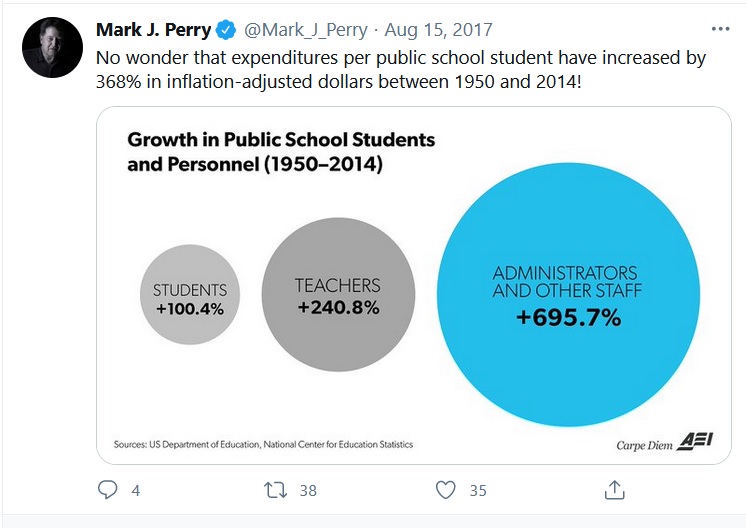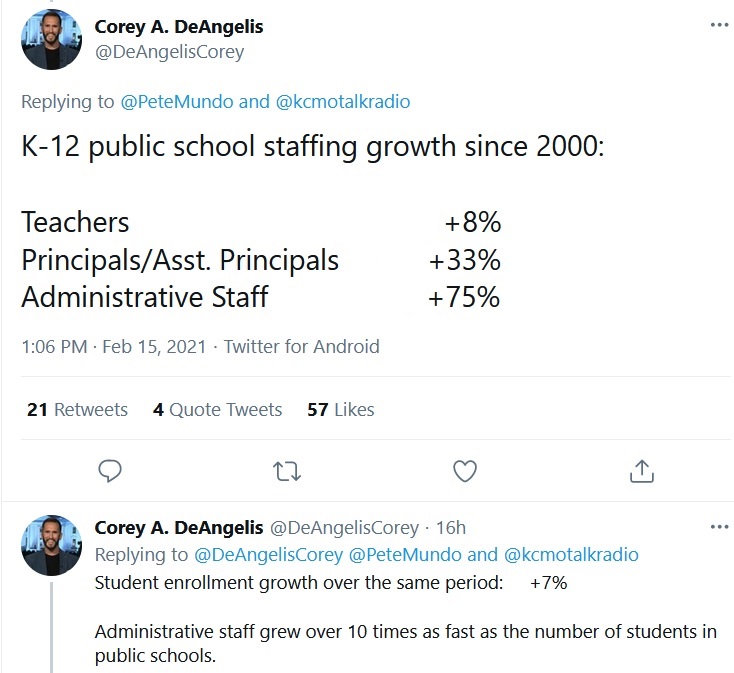Whenever I’m asked to give an example of a powerful and persuasive visual, I always have an easy answer.

The late Andrew Coulson created a very compelling chart showing that huge increases in money and staff for government schools have not led to improvements in educational outcomes. All rational people who look at that image surely will understand that we’re doing something wrong. And if they review the academic evidence on government spending and educational results, they’ll definitely know we’re doing something wrong. The international data, by the way, tells the same story. Which is especially disheartening since Americans taxpayers spend much more on education than their counterparts in other developed nations.
Let’s further investigate this issue.

I came across a 2017 tweet from Mark Perry that gives us another way of looking at the numbers.
He reviewed 64 years of data and found that government spending on education soared by 368 percent. And that’s after adjusting for inflation.
We got more teachers with all that money, but the main outcome was a massive expansion in the number of education administrators and other bureaucrats.
In other words, most of the additional money isn’t being used for classroom instruction.
And the numbers seems to get worse every year. In a recent article for Education Next, Ira Stoll uses two different data sets to document the growth of bureaucracy.
Here is some of the data he got from the Department of Labor.
Are schools really spending more on administration than they used to? The short answer is yes. …information to corroborate the idea of skyrocketing administrative spending may be obtained from a different source: the U.S. Bureau of Labor Statistics. …The category of “education administrators, kindergarten through secondary” in May 2019 included 271,020 people earning a mean annual wage of $100,340. In 1999, there were 186,220 people in this category, earning a mean annual wage of $65,480. That is 45.5 percent growth in the number of administrators. …The math works out to nearly three $100,000-a-year administrators for every school.
Here’s his table based on numbers from the Department of Education.
In each case, we see bureaucrats have been the biggest winners. There are a lot more of them than there used to be, and they enjoy lavish compensation packages.
Cory DeAngelis of Reason summarized Stoll’s findings in a pair of tweets.
Frederick Hess of the American Enterprise Institute explains that all this additional funding and additional bureaucracy is not yielding worthwhile results.
…the U.S. spends more than $700 billion on K–12 education a year, or about $14,000 per student. That’s 39 percent more than the average OECD nation. And many big-city districts spend considerably more,
with per-pupil outlays of more than $20,000 per year in places such as Washington, D.C., and Boston. …But it’s not clear that we’re spending all of this money in effective ways. For instance, …the ranks of non-instructional staff have grown more than twice as fast as student enrollment over the past 30 years. …in public bureaucracies, new dollars often double as a convenient excuse to avoid hard choices.
So what’s the moral of the story?
I don’t need to write anything because this article in National Review by Cameron Hilditch has a very apt summary.
American taxpayers have been hoodwinked by the whole idea of “public schools.” …We’ve been putting more and more money into the system for decades without reaping more returns for the nation’s children. …schools are advertised to taxpayers as institutions that serve every child in the nation. In reality, they serve the interests of no one other than the small group of Americans who work in these schools as teachers and administrators. …Since the teachers unions can shield their own avarice with claims of “public service” to children, they can manipulate the actual public into thinking that more money, job security, or political power for themselves is in everyone’s interest instead of their own. …a look at graduation rates, test scores, and graduate employability calls this into question.
P.S. While this column has mostly focused on the ever-expanding number of administrators and other education bureaucrats, as well as their lavish salaries, it’s worth noting that compensation for teachers also has been going up.
P.P.S. Though the real problem is not teacher pay. Some deserve more pay, some deserve less pay, and some deserve to be fired, but we can’t separate the wheat from the chaff because teacher unions and local politicians have created an inefficient system that delivers mediocrity.
P.P.P.S. We need school choice so that competitive pressure rewards the best teachers as part of a system that focuses on better results for students.


No comments:
Post a Comment